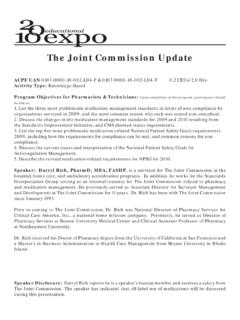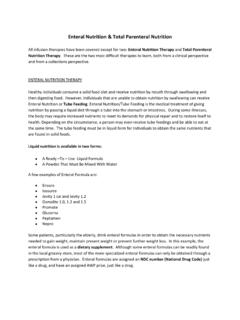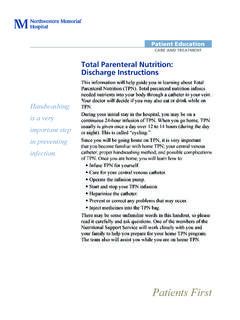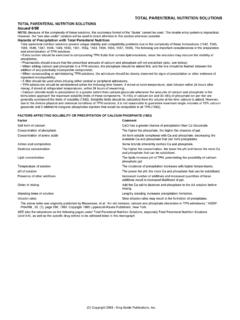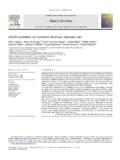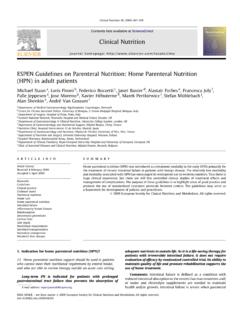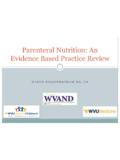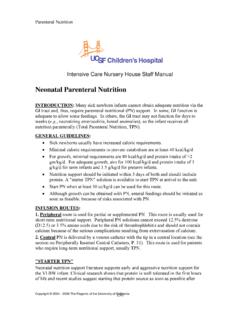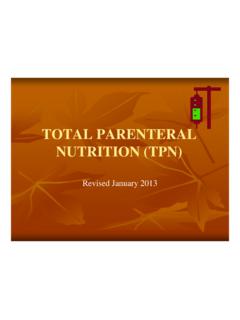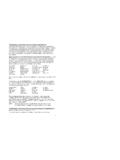Transcription of B4. PHARMACISTS ELECTROLYTE MANAGEMENT IN ADULT …
1 FEBRUARY 7-9, 2014 | THE MEADOWS EVENTS & CONFERENCE CENTER | ALTOONA, IOWAB4. PHARMACISTSELECTROLYTE MANAGEMENT IN ADULT PARENTERAL NUTRITION3:15 - 4:15 PMACPE UAN: 107-000-14-032-L01-P hrActivity Type: Application-BasedLearning Objectives for PHARMACISTS : Upon completion of this CPE activity participants should be able to:1. Identify common causes of sodium, potassium, and phosphorus derangements in hospitalized ADULT patients on parenteral nutrition2. Calculate sodium concentrations in parenteral nutrition solutions and relate them to sodium content of common maintenance solutions3. Recommend appropriate doses of potassium for supplementation via parenteral nutrition4. Predict which patients need phosphorus supplementation in parenteral nutrition5. Devise appropriate monitoring for ELECTROLYTE supplementation in parenteral nutritionSpeaker: Janet Fischer, PharmD, graduated with a Doctor of Pharmacy from Creighton University.
2 She is currently Professor of Pharmacy at South Dakota State University and Clinical Pharmacist at Sanford USD Medical Center in Sioux Falls, SD. Janet has been a member of Sanford s nutrition Support Team for over 25 years and serves as coordinator of their nutrition Committee. At SDSU, Janet teaches in the areas of nutrition , acid-base and hospital practice; is co-coordinator of the P3 pharmacy practice sequence; and takes APPE students in Internal Medicine and nutrition . Speaker Disclosure: Janet Fischer reports no actual or potential confl icts of interest in relation to this CPE activity. Off-label use of medications will not be discussed during this FISCHER, OF PHARMACY PRACTICESDSU COLLEGE OF PHARMACYCLINICAL PHARMACIST/NUTRITIONSUPPORT TEAM PHARMACISTSANFORD USD MEDICAL CENTERSIOUX FALLS, SDElectrolyte MANAGEMENT in ADULT Parenteral nutrition : Focus on Sodium, Potassium, and PhosphorusFaculty Disclosure Janet Fischer reports she does not have actual or potential conflicts of interest associated with this presentation Janet Fischer has indicated that off-label use of medication will not be discussed during this presentation2 Learning ObjectivesUpon completion of this activity, PHARMACISTS (or pharmacy technicians/student PHARMACISTS ) should be able common causes of sodium, potassium, and phosphorus derangements in hospitalized ADULT patients on parenteral nutrition (PN).
3 Sodium concentrations in PN solutions and relate them to sodium content of common maintenance appropriate doses of potassium for supplementation vial which patients need phosphorus supplementation in appropriate monitoring for ELECTROLYTE supplementation in Components Dextrose Amino Acids Fat Emulsion Electrolytes Vitamins Trace Minerals Medications3 Which method of PN compounding do you use?A. Gravity Fill, non-automated transfersB. Automated compounder for large volume additivesC. Automated compounder for small volume additivesD. Ready to Mix Commercial ProductsWhich method of ELECTROLYTE MANAGEMENT in PN do you use?A. All electrolytes added individuallyB. Base electrolytes contained in amino acids sourceC. Base electrolytes from premixed vialA. Easy to add or reduce contentB. Easy to add, harder to reduce content4 How do you order/label electrolytes in ADULT PN?
4 A. Per dayB. Per bagC. Per literASPEN Statement on Parenteral nutrition Standardization: amount/day is required, amount/Liter optionalKochevar M et al. JPEN 2007PN Use in ADULT Patients Critically ill patients who can t tolerate enteralnutrition Respiratory Failure Renal Failure Surgical patients with prolonged GI recovery Ileus or Obstruction Fistulas Short Bowel Pancreatitis Oncology Patients with GI disorders5 Usual ELECTROLYTE Content of PN No guidelines established Often determined by compounding method, products used Must be individualized to the patient ELECTROLYTE levels Concurrent IV fluids Medications Disease states Usual ELECTROLYTE Content of PNElectrolyteUniversity of VAPN Handbook1 Madsen and Frankel2 German PN Guidelines3 Sodium70-100 mEq/day0-200 mEq/L60-150 mEq/dayPotassium70-100 mEq/day0-240 mEq/day40-100 mEq/dayPhosphorus40-60 mEq/day0-60 mMol/day10-30 mMol/dayReferences:1.
5 Abad-Jorge A. University of VA Healthcare System. Madsen H and Frankel EH. Practical Gastroenterology July, Biesalski HK. Ger Med Sci. 2009; 7: Doc21. 6 Common Products UsedProductTPN ElectrolytesAmino Acids with Electrolytes (after 50% dilution)CliniMix-ENa35 mEq/20 ml33-39 mEq/L35 mEq/LK20 mEq/20 ml33 mEq/L30 mEq/LPhos0 typically add 10-15 mM Kphoswhich adds 15-21 mEq/L of K15 mEq/L15 mM/LSodium (Na) Derangements in PN patients Extracellular Cation Normal Serum Level: 135/145 mEq/L Hypernatremia Hyponatremia Serum osmolality - helpful in evaluation Fluid status - key element Hypovolemic Isovolemic/Normovolemic Hypervolemic7 Hyponatremia Symptoms: N, V, HA, muscle cramps, confusion, lethargy, seizure, coma Severity related to rate of onset Most patients have low serum osmolality (hypotonic) Exceptions: Severe hyperlipidemia (isotonic) Hyperglycemia (hypertonic) Calculation of Corrected Serum Na in setting of high BS.
6 Corrected Na = Measured Na + BS 100 x Hyponatremia Causes Hypovolemic Adrenal Insufficiency Excessive Diuresis thiazides and osmotic diuretics Blood Loss GI Losses V, NG suction, Diarrhea Skin Losses sweat or burns Hypervolemic Cirrhosis Heart Failure Nephrotic Syndrome Renal Failure8 Hypotonic Hyponatremia Causes Isovolemic SIADH CNS Disorders Malignancy Medications carbamazepine, SSRI s, TCA s, NSAIDs, others Pulmonary Infections Pain Trauma HypothyroidismHyponatremia Treatment Severe symptomatic Fluid restriction Hypertonic (3%) Saline small boluses of 100 ml or slow IV infusion Normal Saline (NS) Loop Diuretics Correct at rate 1-2 mEq/L per hour, 4-6 (not more than 9) mEq/L in 24 hours Check Na levels every 2 hours Treatment occurs outside of PN9 Hyponatremia Treatment Asymptomatic Hypovolemic - NS Isovolemic Fluid restriction, low dose loop diuretics if needed Hypervolemic Fluid restriction, loop diuretics Correct at rate of mEq/L per hour PN Adjustments can play role Both Identify and treat causePN Implications for Hyponatremia Patients who need fluid restriction Maximize Concentration of PN to reduce fluid provisions Increase dextrose to 25-30% Increase amino acids to 7-10% Patients who need NS Increase Na content of PN if low Adjust Na content of PN to = NS Patients who need loop diuretics Monitor for Hypokalemia Daily monitoring of Na levels10 Hyponatremia CaseA 65 yo, 80 kg male is in ICU following a Whipple procedure.
7 He has been on PN for 3 days pre-op. He is up 8 Liters of fluid since OR yesterday, and 13 liters since admit. He was extubated after surgery but is now requiring 10 L O2 per NC and complaining of SOB. CXR is consistent with pulmonary : Glucose 145, Na 131, K , Cl 97, Mg , phos type of Hyponatremia does he likely have?A. HypovolemicB. IsovolemicC. HypervolemicHyponatremia CaseA 65 yo, 80 kg male is in ICU following a Whipple procedure. He has been on PN for 3 days pre-op. He is up 8 Liters of fluid since OR yesterday, and 13 liters since admit. He was extubated after surgery but is now requiring 10 L O2 per NC and complaining of SOB. CXR is consistent with pulmonary : Glucose 145, Na 131, K , Cl 97, Mg , phos of the following treatments is/are preferred?A. 3% SalineB. Loop DiureticC. Normal SalineD. Fluid Restriction11PN Adjustment with Clinimix His current PN is as follows:Clinimix with 20% Dextrose running 100 ml/hr to provide 2040 kcals/d with 102 gram protein/d.
8 It has Na 35 mEq/L in of the following would be the best adjustment to the PN?A. Change PN to Clinimix 5% AA with 25% dextrose and reduce rate to 80 Change PN to Clinimix AA with 10% dextrose and increase rate to 150 ml/hrC. Add 110 mEq/L of NaCl to = NSPN Adjustment with Compounded PNHis current PN is as follows:5% Amino Acids with 20% Dextrose running 85 ml/hr to provide 1795 kcals/d with 102 gram protein/d. It has Na 100 mEq/L in of the following would be the best adjustment to the PN?A. Decrease Na to 35 mEq/LB. Change to AA with 30% Dextrose and reduce rate to 55 ml/hrC. Change to 9% AA with 33% Dextrose and reduce rate to 50 ml/hrD. Increase Na to 145 mEq/L12 Hyponatremia CaseA 72 kg 65 year old female presents to the hospital with N, V, and abdpain. CT scan of abd reveals a partial small bowel obstruction. NG is placed and returns 2000 ml bilious fluid.
9 Patient is placed on an IV of D51/2NS at 100 ml/hr. On day 5, the obstruction is not resolved and PN is started. On day 7, the maintenance IV is DC d. On day 9, the patient is still getting 1500 ml/d out of NG. PN is running at 60 : Glucose 123, Na 129, K , Cl 98, CO2 31, Mg , phos Which type of hyponatremia does she likely have?A. HypovolemicB. IsovolemicC. HypervolemicHyponatremia CaseA 72 kg 65 year old female presents to the hospital with N, V, and abdpain. CT scan of abd reveals a partial small bowel obstruction. NG is placed and returns 2000 ml bilious fluid. Patient is placed on an IV of D51/2NS at 100 ml/hr. On day 5, the obstruction is not resolved and PN is started. On day 7, the maintenance IV is DC d. On day 9, the patient is still getting 1500 ml/d out of NG. PN is running at 60 : Glucose 123, Na 129, K , Cl 98, CO2 31, Mg , phos Which of the following treatments is/are preferred?
10 A. 3% SalineB. Loop DiureticC. Normal SalineD. Fluid Restriction13 What is the Na content of NS in mEq/L?A. mEq/LB. mEq/LC. 77 mEq/LD. 154 mEq/LE. 512 mEq/LNa Addition to CliniMix Labs: Glucose 123, Na 129, K , Cl 98, CO2 31, Mg , phos PN is running at 60 ml/hr. Pharmacy uses CliniMix E which contains 35 mEq/L of Na. How many mEq/L of Na should be added to make the bag = NS?A. 104 mEq/LB. 119 mEq/LC. 154 mEq/LD. 187 mEq/L14Na Addition to CliniMix Labs: Glucose 123, Na 129, K , Cl 98, CO2 31, Mg , phos PN is running at 60 ml/hr. Pharmacy uses CliniMix E which contains 35 mEq/L of Na. How many mEq/L of Na should be added to make the bag = NS?A. 104 mEq/LB. 119 mEq/LC. 154 mEq/LD. 187 mEq/LNa Addition to Compounded PNLabs: Glucose 123, Na 129, K , Cl 98, CO2 31, Mg , phos PN is running at 60 ml/hr. Pharmacy makes a compounded PN bag for 24 hours that contains a total of 100 mEq of Na per day.
